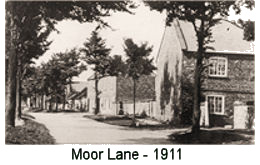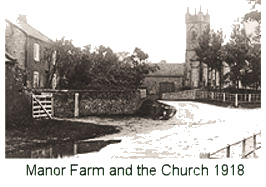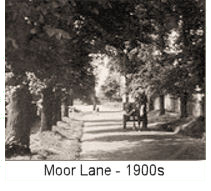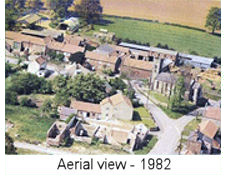Brief outline of Arkendale's history
 In the Domesday Book of 1086 the version of the village name is Arghendene or Archeden and in 1166 it appears as Herchenden, but these are the only time these versions occur, and they were not written by local scribes. Erkendene was the usual spelling.
In the Domesday book the entry for Arkendale was - Hundred: Burghshire; Total tax paid: 3.5 geld (medium); Taxable value 5 geld; Value to lord in 1066 £2.2; Value to lord in 1086 £0.3; Ploughland: 2.5 ploughlands (land for); Lord in 1066: Gamal son of Barth; Lord in 1086: Gamal son of Barth; Tenant-in-chief in 1086: Erneis of Buron.
In the Domesday Book of 1086 the version of the village name is Arghendene or Archeden and in 1166 it appears as Herchenden, but these are the only time these versions occur, and they were not written by local scribes. Erkendene was the usual spelling.
In the Domesday book the entry for Arkendale was - Hundred: Burghshire; Total tax paid: 3.5 geld (medium); Taxable value 5 geld; Value to lord in 1066 £2.2; Value to lord in 1086 £0.3; Ploughland: 2.5 ploughlands (land for); Lord in 1066: Gamal son of Barth; Lord in 1086: Gamal son of Barth; Tenant-in-chief in 1086: Erneis of Buron.
The lower part of the village was known as Arkendale Loftus, later Low Arkendale. The name Loftus comes from the Norse meaning a house with lofts; perhaps there was originally a hunting lodge in the area, as they were built in this way.This would be quite feasible, given the proximity of Hay-a-Park, where successive monarchs had a deer park and a house with a good vantage point would be most useful to view the game. There was certainly a hunting lodge there in 15th century.
 Arkendale lay in the West Riding, but since the 1974 boundary changes is in North Yorkshire. In 1086 at the time of the Domesday survey most of Arkendale and parts of Loftus were being cultivated, unlike other parts of the north which had been laid waste by William the Conqueror, and had been granted by the King to Erneis de Burun, who sub-let it to Gamall. A man called Kalmann had the rest. Some of Erneis' land descended to Hilary Trussebut and some time between 1204 and 1209 gave this land which formed Arkendale Manor, to Lilleshall Abbey in Shropshire. A local man was appointed as bailiff.
Arkendale lay in the West Riding, but since the 1974 boundary changes is in North Yorkshire. In 1086 at the time of the Domesday survey most of Arkendale and parts of Loftus were being cultivated, unlike other parts of the north which had been laid waste by William the Conqueror, and had been granted by the King to Erneis de Burun, who sub-let it to Gamall. A man called Kalmann had the rest. Some of Erneis' land descended to Hilary Trussebut and some time between 1204 and 1209 gave this land which formed Arkendale Manor, to Lilleshall Abbey in Shropshire. A local man was appointed as bailiff.
For centuries the village lay within the Honour of Knaresborough and the administration of the rest Arkendale took place from the castle, where the administrative courts were held every three weeks. The villagers were obliged to have their corn ground at the windmill, which belonged to the Honour. So far the first mention of a mill found is in 1341, but it has not proved possible to find a date for its construction.
Windmillhill Field is mentioned in village records for centuries, well after the mill itself had disappeared. In the late summer of 1349 Black Death struck; a great many deaths were recorded in the area, including those of Richard Waldman, Adam atte Gate and William de Layford, who had properties at Arkendale.
 Arkendale lay within the parish of Knaresborough whilst Low Arkendale or Arkendale Loftus, together with Ferrensby, was in the parish of Farnham. The fact that three chaplains living in Arkendale are mentioned in court records between 1343 and 1361 (and given that not every chaplain would necessarily be named in the court records) suggests that there was an early chapel of ease in Arkendale. The first definite mention of a chapel at Arkendale is in May 1392 when the tenants of Arkendale paid 6d for a licence at the Knaresborough Court to have permission to quarry stone from near the River Nidd for a chapel.
Arkendale lay within the parish of Knaresborough whilst Low Arkendale or Arkendale Loftus, together with Ferrensby, was in the parish of Farnham. The fact that three chaplains living in Arkendale are mentioned in court records between 1343 and 1361 (and given that not every chaplain would necessarily be named in the court records) suggests that there was an early chapel of ease in Arkendale. The first definite mention of a chapel at Arkendale is in May 1392 when the tenants of Arkendale paid 6d for a licence at the Knaresborough Court to have permission to quarry stone from near the River Nidd for a chapel.
In the sixteenth century Arkendale Manor was taken over by Henry VIII and sold with the rest of Lilleshall Abbey's lands. At the Reformation Henry had created the Church of England, but like many others Laurence Toller (Towlard), who died in 1547, was still attached to Roman Catholic tradition for he left his soul in his will to God and "Our blessed lady Saint Mary."
Most people in the village made their living from farming. Some combined farming and other jobs, working as weavers or tailors. Dennis Tollerd who died in 1617 was a tailor, so clothes were important to him; he left his brother Marmaduke his best hat, doublet, britches, jerkin, shirt and shirt band, stockings, shoes and garter. What a fine sight he would have been especially with his best cloak, which he left to his cousin. Like many people at the time he left money to the poor as well as to his own family.
During the Civil War two soldiers died at Arkendale in 1640 and 1641 and were buried at Farnham. It is said that Cromwell visited The Blue Bell, but there is no definite evidence for this! Arkendale men were probably called to fight at the Battle of Marston Moor and the siege at Knaresborough Castle in 1644.
 Many properties were built or re-built in the early 1700s, when the Lord of the Manor of Arkendale was Robert Byerley, who lived at Goldsborough.The landscape would change from the three field open farming system with the Enclosure Act for Arkendale in 1773. In 1883 Joseph Nussey of Leeds bought the manor of Arkendale from Morton Eden; Nussey's son had Arkendale Hall built in 1909.The manor was sold as a whole in 1970 and some parts have since been sold on.
Many properties were built or re-built in the early 1700s, when the Lord of the Manor of Arkendale was Robert Byerley, who lived at Goldsborough.The landscape would change from the three field open farming system with the Enclosure Act for Arkendale in 1773. In 1883 Joseph Nussey of Leeds bought the manor of Arkendale from Morton Eden; Nussey's son had Arkendale Hall built in 1909.The manor was sold as a whole in 1970 and some parts have since been sold on.
The village remained a predominantly farming community, with several smallholdings, well into the 20th century. In 1838 there were three shoemakers, a wheelwright (who worked for the Estate), a shopkeeper, tailor, gardener, a blacksmith and several farmers.
In 1850s Peter Whincup was postmaster. There was a Post Office and shop run by Tom Elliott, as well as a shop run by Mrs Emma Marshall at Low Arkendale in 1910s and 1920s. The Post Office was by the 1970s in a private bungalow and finally closed in 1989. Today there isn't a shop. The Blue Bell sells drinks and has a restaurant. Social events take place there, but mainly in the Village Hall, a converted 1st World War army hut from Ripon, or in private homes.
 A village school was opened in 1867 and closed in 1947, when children were transferred to Staveley Community Primary School; a school bus takes children there today. A Primitive Methodist Chapel, which was built in 1860s, ceased being used in 1930s whilst the Wesleyan Methodist Chapel was built in 1824, used until 1950s; both have been converted into homes. In 1983 the buildings of Manor Farm were demolished and new houses built. Since then farm buildings have been converted and new homes erected at Holgate Bank Farm, Grange Farm and Dale House Farm.
A village school was opened in 1867 and closed in 1947, when children were transferred to Staveley Community Primary School; a school bus takes children there today. A Primitive Methodist Chapel, which was built in 1860s, ceased being used in 1930s whilst the Wesleyan Methodist Chapel was built in 1824, used until 1950s; both have been converted into homes. In 1983 the buildings of Manor Farm were demolished and new houses built. Since then farm buildings have been converted and new homes erected at Holgate Bank Farm, Grange Farm and Dale House Farm.
For family historians with Arkendale ancestors: from 1561 baptisms, marriages and burials are all in the Knaresborough Parish Registers and in many instances the name of the village is not stated; this often depended on who wrote the entries. From 1793 Arkendale baptisms definitely took place at Arkendale, as there is a separate register. Indeed, baptisms probably occurred there from 1780, as an earlier register was lost, but the Bishop's Transcripts for Knaresborough have separate lists of village baptisms on them. Marriages were solemnised at Arkendale from 1837. It is difficult to say with certainty when the first burials took place in the village. People from Low Arkendale were buried at Farnham. In the 16th and 17th centuries people from Arkendale asked in their wills to be buried in churchyard at Knaresborough. There were later burials at Arkendale. In 1893 land was given by Mr J. H. Nussey for a separate village cemetery. St. Bartholomew's was demolished in 1836 and the replacement was the first consecrated building of the newly formed Diocese of Ripon. The registers can be consulted on microfilm at the North Yorkshire Record Office at Northallerton.
© Ruth Wilcock, 2003
Ruth's ancestors, the Towlard family, lived in Arkendale for several hundred years, farming and running the alehouse which became known as The Blue Bell. In 1986 she published Arkendale - its Church and People (Towlard Publications, Brentwood, Essex, 1986. ISBN: 0951171100), to coincide with the 150th anniversary of the construction of the present Church. This was updated in 2001. It mentions many families and some general as well as church and chapel history. It is now out of print, but anyone with genealogical queries can post a message on the Family History page.